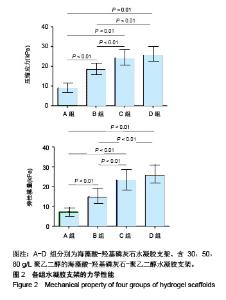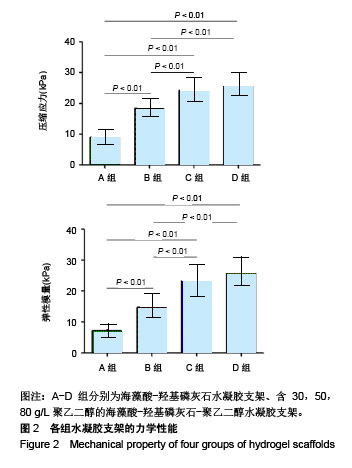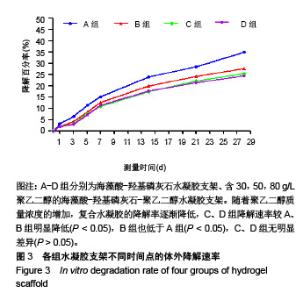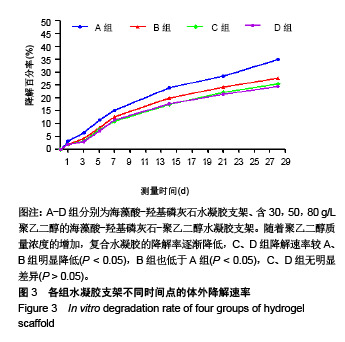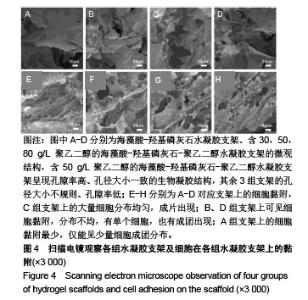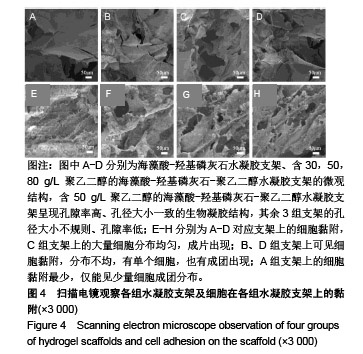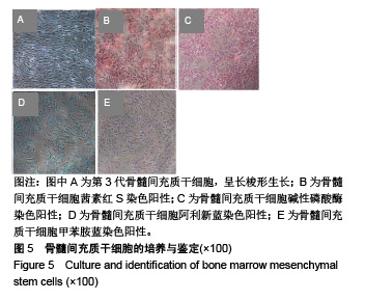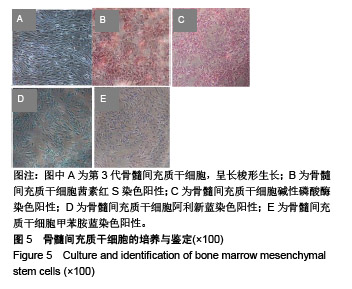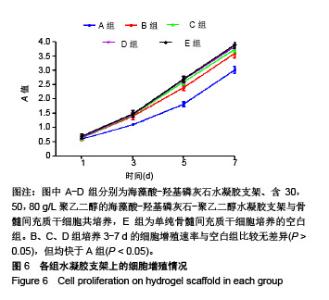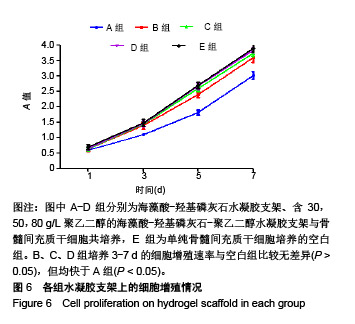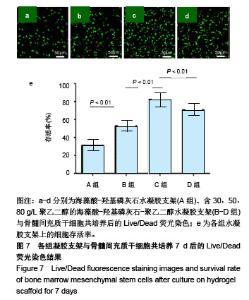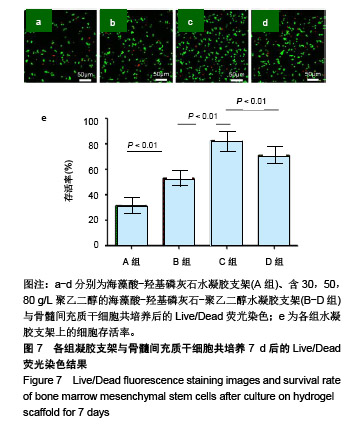Chinese Journal of Tissue Engineering Research ›› 2019, Vol. 23 ›› Issue (26): 4230-4236.doi: 10.3969/j.issn.2095-4344.1365
Previous Articles Next Articles
Preparation of sodium alginate-hydroxyapatite-polyethylene glycol composite hydrogel scaffold and its biocompatibility
-
Received:2019-04-22Online:2019-09-18Published:2021-04-29 -
Contact:Ye Chuan, Chief physician, Department of Orthopedics, Affiliated Hospital of Guizhou Medical University, Guiyang 550004, Guizhou Province, China; National-Guizhou Joint Engineering Laboratory of Cell Engineering and Biomedicine Technique, Guiyang 550004, Guizhou Province, China; Research Center of Tissue Engineering and Stem Cell Technique, Guizhou Medical Univesity, Guiyang 550004, Guizhou Province, China -
About author:Li Xuanze, Master candidate, Physician, Guizhou Medical University, Guiyang 550004, Guizhou Province, China; Department of Orthopedics, Affiliated Hospital of Guizhou Medical University, Guiyang 550004, Guizhou Province, China; National-Guizhou Joint Engineering Laboratory of Cell Engineering and Biomedicine Technique, Guiyang 550004, Guizhou Province, China -
Supported by:the National Natural Science Foundation of China, No. 81360232 (to YC); Guiyang Science and Technology Bureau Innovation Team Project, No. [2017]5-17 (to YC); an Open Project of Key Laboratory of Adult Stem Cell Transplantation of Chinese Academy of Medical Sciences, No. 2018YB04 (to YL); a Project of Guizhou Provincial Department of Education, No. qianjiaohe-KY[2017]161 (to YL)
CLC Number:
Cite this article
Li Xuanze, Shu Liping, Chen Jiao, Sun Yu, Zou Qiang, Wang Weiyu, Liu Jun, Yang Long, Ma Minxian, Ye Chuan. Preparation of sodium alginate-hydroxyapatite-polyethylene glycol composite hydrogel scaffold and its biocompatibility[J]. Chinese Journal of Tissue Engineering Research, 2019, 23(26): 4230-4236.
share this article
| [1]Bao X,Zhu L,Huang X,et al.3D biomimetic artificial bone scaffolds with dual-cytokines spatiotemporal delivery for large weight-bearing bone defect repair.Sci Rep. 2017;7(1):645-657.[2]Cui Y,Zhu T,Li A,et al.Porous Particle-Reinforced Bioactive Gelatin Scaffold for Large Segmental Bone Defect Repairing.ACS Appl Mater Interfaces. 2018;10(8):6956-6964.[3]Han Z,Bhavsar M,Leppik L,et al.Histological Scoring Method to Assess Bone Healing in Critical Size Bone Defect Models.Tissue Eng Part C Methods. 2018;24(5):272-279.[4]葛振,邹刚,刘毅,等.组织工程支架材料:特征及在组织工程中的应用[J].中国组织工程研究, 2018,22(26):4222-4228.[5]Fercana GR,Yemeni S,Billaud M,et al.Perivascular extracellular matrix hydrogels mimic native matrix microarchitecture and promote angiogenesis via basic fibroblast growth factor. Biomaterials. 2017;123(38):142-154.[6]Mahumane GD,Kumar P,du Toit LC,et al.3D scaffolds for brain tissue regeneration: architectural challenges.Biomater Sci.2018;6(1):2812-2837.[7]王雨生,张楠,陈海华.高G 型海藻酸钠-明胶pH 敏感型复合水凝胶的制备与性质[J].中国食品学报,2017, 17(8):132-139.[8]李亮,喻航达,邱唯楚,等.海藻酸钠/氧化石墨烯复合水凝胶的制备与性能[J].武汉工程大学学报,2018, 40(6):641-644.[9]Luo H,Zuo G,Xiong G,et al.Porous nanoplate-like hydroxyapatite–sodium alginate nanocomposite scaffolds for potential bone tissue engineering.Mater Technol. 2017;32(2): 78-84.[10]Liao L,Wang B,Huang Y,et al.Injectable Alginate Hydrogel Cross-Linked by Calcium Gluconate-Loaded Porous Microspheres for Cartilage Tissue Engineering.ACS Omega. 2017;2(2):443-454.[11]叶思,平其能,孙敏捷.海藻酸钠在生物医药领域的应用与研究进展[J].药学与临床研究,2018,26(2): 120-129.[12]Saini R,Bagri L,Bajpai AK. Nano-silver hydroxyapatite based antibacterial 3D scaffolds of gelatin/alginate/poly (vinyl alcohol) for bone tissue engineering applications. Colloids Surf B Biointerfaces. 2019;177(18):211-218.[13]Sathiyavimal S,Vasantharaj S, Lewis Osca F,et al. Biosynthesis and characterization of hydroxyapatite and its composite (hydroxyapatite-gelatin-chitosan-fibrin-bone ash) for bone tissue engineering applications.Int J Biol Macromol. 2019; 34(16):288-296.[14]杨慎宇,唐三元,谭文成,等.羟基磷灰石接枝壳聚糖表面改性及其复合水凝胶的生物相容性[J].材料研究学报, 2015,29(1):801-806.[15]席征,蒿银伟,张志国,等.化学交联聚乙二醇水凝胶的制备方法[J].化学推进剂与高分子材料,2011,9(3): 36-43.[16]Nam S,Stowers R,Lou J, et al.Varying PEG density to control stress relaxation in alginate-PEG hydrogels for 3D cell culture studies.Biomaterials.2019;200(38):15-24.[17]乔从德.聚乙二醇基智能水凝胶的研究进展[J].高分子通报, 2010,3(1):23-30.[18]Chen P,Liu L,Pan J,et al.Biomimetic composite scaffold of hydroxyapatite/gelatin-chitosan core-shell nanofibers for bone tissue engineering.Mater Sci Eng C. 2019;97(23):325-335. [19]Xin X,Wu J,Zheng A.Delivery vehicle of muscle-derived irisin based on silk/calcium silicate/sodium alginate compositescaffold for bone regeneration.Int J Nanomedicine.2019; 14(5):1451-1467. [20]Kolanthai E,Sindu A,Khajuria D,et al.Graphene Oxide–A Tool for Preparation of Chemically Crosslinking Free Alginate-Chitosan-Collagen Scaffold for Bone Tissue Engineering. ACS Appl Mater Interfaces. 2018;10(15): 12441-12452.[21]吴刚,赵春华,王成焘,等.羟基磷灰石/聚乙烯醇水凝胶的制备与生物活性评价[J].中国组织工程研究, 2010,14(34):6323-6327.[22]Yan J,Miao Y,Tan H,et al.Injectable alginate/hydroxyapatite gel scaffold combined with gelatin microspheres for drug delivery and bone tissue engineering.Mater Sci Eng C. 2016;63(25):274-284.[23]Giuseppe M,Nicholas L,Braeden W,et al.Mechanical behaviour of alginate-gelatin hydrogels for 3D bioprinting.J Mech Behav Biomed Mater.2018;79(18):150-157.[24]Wang L,Deng F,Wang W,et al.Construction of Injectable Self-Healing Macroporous Hydrogels via a Template-Free Method for Tissue Engineering and Drug Delivery. ACS Appl Mater Interfaces.2018;10(43): 36721-36732. [25]田思宇,杨龙,王超,等. PEG对双组分AM-MBAM-YSZ凝胶打印浆料性能的影响[J].硅酸盐通报,2017, 36(9):3139-3154.[26]Zhao G,Zeng Q,Zhang S,et al.Effect of Carrier Lipophilicity and Preparation Method on the Properties of Andrographolide-Solid Dispersion. Pharmaceutics. 2019; 11(2):74-82.[27]Wang L,Lu C,Zhang B,et al. Fabrication and characterization of flexible silk fibroin films reinforced with graphene oxide for biomedical applications.RSC Adv. 2014;4(76):40312-40320.[28]Xu Q,Ji Y,Sun Q, et al. Fabrication of Cellulose Nanocrystal/ Chitosan Hydrogel for Controlled Drug Release. Nanomaterials.2019;9(2):253-264.[29]Wang J,You M,Ding Z,et al.A review of emerging bone tissue engineering via PEG conjugated biodegradable amphiphilic copolymers.Mater Sci Eng C Mater Biol Appl. 2019;97(34): 1021-1035.[30]Engin P,Özge E,Dilek K, et al.Clinoptilolite/PCL-PEG-PCL composite scaffolds for bone tissue engineering applications.J Biomater Appl.2017;31(20):1148-1168.[31]Perez J,Dimitrios K,Li D,et al.Tissue Engineering and Cell-Based Therapies for Fractures and Bone Defects.Front Bioeng Biotechnol.2018;31(13):96-105.[32]Wu T,Yu S,Chen D,et al.Bionic Design, Materials and Performance of Bone Tissue Scaffolds. Materials. 2017; 10(10):1187-1195.[33]Henkel J, Woodruff M,Epari D,et al.Bone Regeneration Based on Tissue Engineering Conceptions - A 21st Century Perspective.Bone Res.2013;1(3):216-248.[34]Narjes K,Akbar K,Morteza D.Preparation and characterization of (PCL-crosslinked-PEG)/hydroxyapatite as bone tissue engineering scaffolds.J Biomed Mater Res A. 2015;103(8): 3919-3926.[35]Ulrich B,Stéphanie M,Queralt V,et al.Dual Role of Mesenchymal Stem Cells Allows for Microvascularized Bone Tissue-Like Environments in PEG Hydrogels.Adv Healthc Mater.2016;5(28): 489-498.[36]Nabavinia M,Khoshfetrat A,Hojjat N. Nano-hydroxyapatite- alginate-gelatin microcapsule as a potential osteogenic building block for modular bone tissue engineering.Mater Sci Eng C Mater Biol Appl. 2019;97(7):67-77.[37]Wang Y,Ma M,Wang J,et al.Development of a Photo-Crosslinking, Biodegradable GelMA/PEGDA Hydrogel for Guided Bone Regeneration Materials. Materials(Basel). 2018;11(21):367-378.[38]Gao G,Yonezawa T,Hubbell K,et al.Inkjet-bioprinted acrylated peptides and PEG hydrogel with human mesenchymal stem cells promote robust bone and cartilage formation with minimal printhead clogging.Biotechnol J. 2015;10(8): 1568-1577.[39]Gao G,Schilling AF,Hubbell K,et al.Improved properties of bone and cartilage tissue from 3D inkjet-bioprinted human mesenchymal stem cells by simultaneous deposition and photocrosslinking in PEG-GelMA.Biotechnol Lett. 2015; 37(27):2349-2355. |
| [1] | Liu Jiangfeng. Nano-hydroxyapatite/polyamide 66 composite filling combined with locking plate in the treatment of fibrous dysplasia of femoral bone [J]. Chinese Journal of Tissue Engineering Research, 2021, 25(4): 542-547. |
| [2] | Li Li, Ma Li. Immobilization of lactase on magnetic chitosan microspheres and its effect on enzymatic properties [J]. Chinese Journal of Tissue Engineering Research, 2021, 25(4): 576-581. |
| [3] | Zhang Zhenkun, Li Zhe, Li Ya, Wang Yingying, Wang Yaping, Zhou Xinkui, Ma Shanshan, Guan Fangxia. Application of alginate based hydrogels/dressings in wound healing: sustained, dynamic and sequential release [J]. Chinese Journal of Tissue Engineering Research, 2021, 25(4): 638-643. |
| [4] | Liu Fang, Shan Zhengming, Tang Yulei, Wu Xiaomin, Tian Weiqun. Effects of hemostasis and promoting wound healing of ozone sustained-release hydrogel [J]. Chinese Journal of Tissue Engineering Research, 2021, 25(22): 3445-3449. |
| [5] | Liu Jun, Yang Long, Wang Weiyu, Zhou Yuhu, Wu Ying, Lu Tao, Shu Liping, Ma Minxian, Ye Chuan. Preparation and properties of poly3-hydroxybutyrate 4-hydroxybutyrate/polyethylene glycol/graphene oxide tissue-engineered scaffolds [J]. Chinese Journal of Tissue Engineering Research, 2021, 25(22): 3466-3472. |
| [6] | Li Xinping, Cui Qiuju, Zeng Shuguang, Ran Gaoying, Zhang Zhaoqiang, Liu Xianwen, Fang Wei, Xu Shuaimei. Effect of modification of β-tricalcium phosphate/chitosan hydrogel on growth and mineralization of dental pulp stem cells [J]. Chinese Journal of Tissue Engineering Research, 2021, 25(22): 3493-3499. |
| [7] | Liu Liyong, Zhou Lei. Research and development status and development trend of hydrogel in tissue engineering based on patent information [J]. Chinese Journal of Tissue Engineering Research, 2021, 25(22): 3527-3533. |
| [8] | He Lin, Wu Xi, He Song, Yang Sen. Hydrophilicity and cell adhesion of hydroxyapatite bioceramics after the coating of polydopamine [J]. Chinese Journal of Tissue Engineering Research, 2021, 25(22): 3540-3544. |
| [9] | Zhou Anqi, Tang Yufei, Wu Bingfeng, Xiang Lin. Designing of periosteum tissue engineering: combination of generality and individuality [J]. Chinese Journal of Tissue Engineering Research, 2021, 25(22): 3551-3557. |
| [10] | Gan Lili, Xiong Na, Liu Yanfei. Hydrogel as drug scaffold in skin wound repair: challenges of clinical application possibilities [J]. Chinese Journal of Tissue Engineering Research, 2021, 25(22): 3578-3583. |
| [11] | Lang Limin, He Sheng, Jiang Zengyu, Hu Yiyi, Zhang Zhixing, Liang Minqian. Application progress of conductive composite materials in the field of tissue engineering treatment of myocardial infarction [J]. Chinese Journal of Tissue Engineering Research, 2021, 25(22): 3584-3590. |
| [12] | Chen Siyu, Li Yannan, Xie Liying, Liu Siqi, Fan Yurong, Fang Changxing, Zhang Xin, Quan Jiayu, Zuo Lin. Thermosensitive chitosan-collagen composite hydrogel loaded with basic fibroblast growth factor retards ventricular remodeling after myocardial infarction in mice [J]. Chinese Journal of Tissue Engineering Research, 2021, 25(16): 2472-2478. |
| [13] | Liu Feng, Zhang Yu, Wang Yanli, Luo Wei, Han Chaoshan, Li Yangxin. Application of temperature-sensitive chitosan hydrogel encapsulated exosomes in ischemic diseases [J]. Chinese Journal of Tissue Engineering Research, 2021, 25(16): 2479-2487. |
| [14] | Zhang Xin, Lu Ying, Yao Qingqiang, Zhu Yishen. Preparation and in vitro evaluation of self-assembling peptide hydrogel loaded with doxorubicin [J]. Chinese Journal of Tissue Engineering Research, 2021, 25(16): 2488-2493. |
| [15] | Wang Renxian, Cao Jingjing, Wang Honggang, Wan Ben, Liu Weifeng. Effects of dispersants on aggregation, intracellular distribution and cell proliferation of nano-hydroxyapatite [J]. Chinese Journal of Tissue Engineering Research, 2021, 25(16): 2500-2505. |
| Viewed | ||||||
|
Full text |
|
|||||
|
Abstract |
|
|||||
